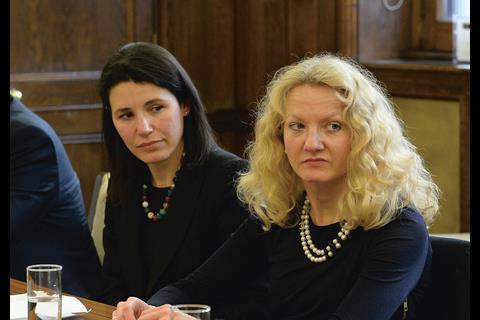Family lawyers take clients through some of the most difficult episodes of their lives – a process complicated by overstretched courts and inconsistent judgments. Eduardo Reyes reports from the latest Gazette roundtable
Clients in family law cases such as divorce and separation rarely want their day in court – what they do want is to get on with the rest of their lives with some certainty, especially where children are involved.
But looming between them and ‘closure’ are numerous obstacles: an overstretched child representation body, judicial inconsistency, perceived gender bias, legal fees and a bewildering choice of dispute resolution options. This is not the ideal landscape in which to set life-changing decisions and determinations.
At the centre of that difficult process are family law specialists, including the nine present at the Gazette’s first family law roundtable.
The discussion begins with one of the most intractable problems faced by separated families in a globalised economy. James Pirrie, director at Family Law in Partnership, observes: ‘I have the sense that the commercial world expects people to change jobs at the drop of a hat [and] move around the world. Yet it’s much harder now to take the kids with you.’
Charles Geekie QC of 1 Garden Court concurs: ‘London is the international commercial centre and that has had a very serious impact upon children moving around the world. A lot of people are expected to come and work for their bank here, for example, having been in Singapore or New York. Their families get dragged around with them and that has a major impact on children.
‘Either their entire family is moving here, or one person is moving – forming a relationship here, having children. We had a reputation until recently [as a jurisdiction where] if the mother, who is the carer, wanted to go off somewhere else, she was likely to be able to do so. I find that is much less so now.’
Cross-border relocation is difficult to mediate, Seddons partner Deborah Jeff notes, because the resolution will likely favour one side only – placing heavy emphasis on the determinative role of the court and the interpretation of the children’s interests.
One option would take away some of the neutrally consensus-seeking aspects of mediation outcomes. Geekie suggests that clients are taking an interest in seeing mediations in family law become ‘more directive’.
Representing the child
Discussion turns to Cafcass, the non-departmental public body charged with representing the interests of children in family courts. It works on slender resources, several attendees note. Funding cuts have restricted its ability to do a thorough job in relocation cases, which would ideally involve a site visit to assess whether the relocation was in the interests of the child.
This resourcing shortfall affects the consistency of decision-making in county courts, notes Felicity Shedden of Shedden Family Law: ‘When you’re in a regional, county court that may be dealing with a very high volume of work, and that doesn’t have Cafcass as easily on tap, the court has to wait longer for reports. The Cafcass officers are under even greater stress.’
Nigel Shepherd, Mills & Reeve partner and vice- chair of Resolution, believes that overstretch results in problems such as Cafcass officers working to out-of-date guidance: ‘I did a case recently in a court centre about 100 miles from London where the Cafcass officer had prepared a report which was obviously a Payne v Payne template. Yet nobody had yet [informed] Cafcass that they had to get away from that template post-K.’
In Re K (A Child), relocation was made considerably harder than in Payne v Payne, formerly the precedent to be followed.
The result is something of a postcode lottery, according to Shepherd. Where people have the resources, he notes, it is increasingly common to ‘try to get an independent social worker’ to write a report.
Geekie enlarges upon the point: ‘I think [this overstretch] is having a very significant impact. I have heard it suggested that in some areas Cafcass is permitted 10 hours on a leave to remove case, which is just not enough time to do the job properly – nothing like enough time.’ He adds: [You might also have] Cafcass officers who have come relatively newly to the job, and who don’t have a long experience of doing assessments.’
The result is that these officers lack ‘the antennae that you need in order to assess what is a very sensitive situation – where the assessment is multifaceted’.
The consistency and even-handedness of judicial decision-making on relocation issues, then, is firmly in the spotlight for this group. Farrer & Co associate Annmarie Carvalho questions whether the issue is sufficiently ‘gender blind’.
She says: ‘I don’t think the law is gender-blind when it comes to issues like international relocation disputes and mothers can sometimes be favoured over fathers. For example, in cases where mother wants to move abroad with the children it can be difficult for fathers to object, even in circumstances where the children have been living here for some time and spending a significant amount of time with the father.’
Permission to move is more easily obtained in the lower courts, others note – with the High Court seemingly more aligned with an international trend that makes cross-border relocation more difficult.
Shepherd says: ‘We are catching up much more with other jurisdictions that make it really quite tough… We know that you could hardly get out of New Zealand, for example. You can’t move very easily from Wisconsin into Illinois. There’s a perception that we’re toughening up [too].’
Despite that background, Geekie notes, it is still possible to negotiate a resolution. He describes the case of a client who had a pre-school age child. The child’s mother wanted to move to a location that was a five-hour flight away. The father’s argument, Geekie recalls, was: ‘He’s just so young, I have no relationship with him yet. If she’ll just wait another 18 months until he’s at school, so while he’s not at school I can build up the relationship, then I’ll feel easier about trying to maintain the long-term relationship.’
He adds: ‘She had wanted to go immediately, [but] after some protracted discussions she agreed to postpone for over 18 months until the younger child was a bit older. So that was quite an inspiring example of a case which can actually reach agreement.’
Overstretch
An overburdened judiciary, inconsistent decision-making and the continued growth in litigants in person are all reasons to consider root-and-branch reform. Philip Rutter, partner at Gordon Dadds, makes the case: ‘The current system can’t cope. There aren’t enough judges, there isn’t enough money, there’s too much vagueness.’
The inconsistencies cited at the table are certainly arresting. Shedden recalls: ‘What is so frightening is the difference geography can make. A year or so ago I had two cases that were almost identical on the facts that were in for FDR [financial dispute resolution] in two courts. I got completely opposing indications on each case – even though the courts were only 40 miles apart.’ She adds: ‘You almost choose the court you want in order to get the outcome you want. That is a very uncomfortable sort of way of advising your client.’
At the table
Grant Howell, Charles Russell Speechlys; Carolina Marín Pedreño, Dawson Cornwell; Deborah Jeff, Seddons; Eduardo Reyes, Law Society Gazette; James Pirrie, Family Law in Partnership; Philip Rutter, Gordon Dadds; Charles Geekie QC, 1 Garden Court; Felicity Shedden, Shedden Family Law; Nigel Shepherd, Mills & Reeve; Annmarie Carvalho, Farrer & Co; Elizabeth Noone, The Law Society
A more certain approach would also be a more prescriptive one however – and more in line with that taken by the Child Maintenance Service, successor to the shambolic and reviled Child Support Agency. There is much criticism of the CMS’s formula.
As Pirrie notes: ‘The formula is just horrible for most people. There’s no relationship to people’s capacity to pay at all in many cases.’ Nevertheless, others say, there is merit in a formula for the division of assets, he adds, because ‘more and more people don’t have advice’ as the number of litigants in person rockets.
Canada is an instructive example where, although assessment varies between provinces, litigants do get a basic indication of the range. Shedden has some experience of this: ‘I spent some time observing in Ontario and Toronto last year. There is this very structured approach of putting in the assets and the length of the marriage, and the answer spits out at the end. But lawyers still litigate a lot. So the fact that they have put in place this formula that will give them the answer doesn’t mean that they don’t have lots of divorce lawyers making a jolly good income out of that work.’
Talk turns to solutions for the problem of courts creaking under the burden of cases. Pirrie insists: ‘What we see is the courts moving from trying to dispense justice into trying to manage numbers. I think it’s now much more an issue of “crowd control”. It can be quite grumpy, as well as a miserable and expensive experience.’
Faced with such challenges, arbitration may have something to offer. ‘Collaborative law’ also enters the conversation.
In arbitration, price, appropriateness, format – even the preferred seniority of the arbitrator – are all points that can lack a clear benchmark. The ‘fixed-price arbitration’ being launched by law firm Hodge Jones & Allen has caught the attention of some. But, Shedden notes, misconceptions about arbitration remain widespread: ‘I think it’s a bit of a mistake to see arbitration as being just about the big money, [with] a big budget, [using] very senior practitioners.’
She explains: ‘I’ve done quite a few arbitrations and the people I’ve arbitrated for wouldn’t want a very senior barrister or retired High Court judge because they’d be terrified of them. They like the fact that I work in a regional practice with very “normal” cases. They’re not after somebody very senior. And if you want to get a retired Court of Appeal or High Court judge to judge your case, of course they’re going to cost more than if you’re getting somebody from the high street.’
Arbitration may be suitable, Shedden adds, ‘if you’ve got a small-asset case where they can’t afford to go through the court. Maybe they’ve tried mediation. They’ve already done their disclosure through mediation, so they’ve possibly had help [with that] under the legal aid scheme. They can come and get an arbitrator decision in a matter of weeks, for a fraction of the cost of going through the court process, with somebody who is at deputy district judge rather than High Court judge level of seniority.’
Charles Russell Speechlys partner Grant Howell notes that a case need not reach arbitration for the option of arbitration to have played a role: ‘We had a case where the parties agreed to arbitration and we got on board with the arbitrator. But we also had a private FDR [meeting], on the basis the private FDR was about three weeks before the arbitration. It settled with the private FDR and we used counsel.’
That wasn’t unusual, counsel then told him: ‘Counsel said to me afterwards – and I think it was quite a perceptive comment – that “most of these sorts of cases will settle at the FDR because they’ve agreed to go to arbitration, so there’s already a consensus”. They’re then put in front of somebody who is very experienced and has the kind of things we have in FDR. So even the fact that it’s there will probably help.’
In the collaborative law process, by contrast, each person appoints their own lawyer, but instead of conducting negotiations by letter and phone, all meet together in a ‘four-way’ meeting. The lawyers, who are Resolution-trained, sign an agreement that disqualifies them from representing the client in court if the collaborative process breaks down.
So far this process has not gained a great deal of traction. Some suspect that lawyers tend to put the disqualification clause ‘front of shop’. Shedden explains: ‘When I’m talking to somebody about collaborative law I don’t say, “the problem is there is a disqualification clause”.
I say: ‘The great thing is, everybody in the room is 100% committed to the process, and everybody has signed a commitment that they won’t walk away from it, including the lawyers. If anybody did decide to litigate the lawyers would stop acting.” I see that as a positive part of the way that the process works.’
Pirrie says: ‘I just try and make it simple. I say, “If you were supported do you think you could reach an agreement?” They say, “Oh, yes”.’ To which Pirrie would reply: ‘Well, let’s do this then. We can start doing it next week… We’ll have it solved in three meetings, and if not we’ll stop and do something else.’
He stresses: ‘People get that.’
Hourly rate
Funding family cases is a challenge at all levels. That can stem from hardship on the part of one or both parties, or clients’ strong preferences for a ‘fixed fee’.
One attendee suggested the hourly rate could be as good as dead within three years. For privately funded cases, what comes in its place is unlikely to be an ‘all-in’ fixed fee. Instead, defined ‘stages’ are likely. This, Shedden notes, is because an all-in fixed fee leads lawyers to ‘chip away at what’s offered’ – pushing work down and away from experienced practitioners.
Where funding is an issue, it may be that some delegation is appropriate. Carvalho says: ‘It might encourage clients in some scenarios to go and speak to more appropriately qualified people like their counsellor or their therapist. There are those long conversations that you have where 5% of it is about the law and 95% of it is about something else.’
Drug, alcohol and substance abuse
Many of the lawyers present feel the challenge in family cases can be to get a fully ‘holistic’ approach to reaching a resolution. Carvalho, who has a particular interest in the part addiction can play, sees the Family Drug and Alcohol Court as a model.
She praises the court’s ‘holistic way of dealing with cases that are diverted out of the public law system’. The FDAC, she notes, has ‘judicial continuity’ and the involvement of housing experts, social workers and psychiatrists: ‘I think it’s fair to say that they are generally experiencing a higher incidence of happy outcomes’.
This is indeed so. According to an evaluation carried out by Brunel University, funded by the Nuffield Foundation and the Home Office, FDAC families were more likely to stop misusing substances and were more likely to be reunited with their children than those who had been through ordinary care proceedings.
She hopes the court, which is to go nationwide, can continue to combat ‘the misunderstanding around addiction and treatment of it as a moral issue rather than as an illness’.
Others endorse her next point as the discussion draws to a close: ‘Rather than looking at everything as being a legal problem, it needs to be recognised that addiction, divorce, separation – these are social problems. Lawyers don’t hold all the answers. We need to draw on a range of professionals to support a family, rather than thinking we can deal with it all ourselves.’
Eduardo Reyes is Gazette features editor

















![David Lester (senior partner at Blythe Liggins), Darryl Barnes, Jagdeep Sandher (head of dispute resolution at Blythe Liggins)[4]](https://d1d8vslyhr7rdg.cloudfront.net/Pictures/274x183/4/2/8/116428_davidlesterseniorpartneratblytheligginsdarrylbarnesjagdeepsandherheadofdisputeresolutionatblytheliggins4_981603_crop.jpg)












2 Readers' comments